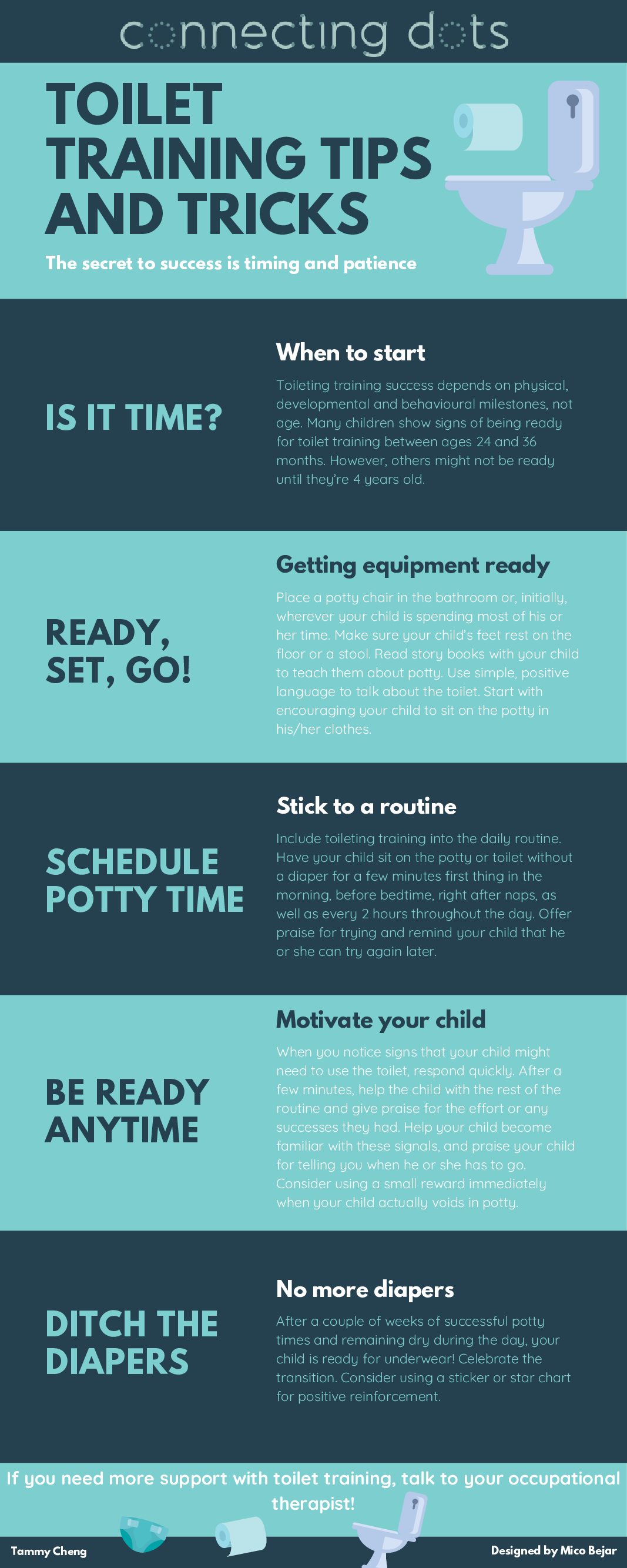Toilet Training Tips and Tricks
By Tammy Cheng
Toilet training involves many steps (discussing, undressing, going, wiping, dressing, flushing, hand washing) and it is a big skill to learn for a child. The secret to success is timing and patience.
Is it time?
Toileting training success depends on physical, developmental and behavioural milestones, not age. Many children show signs of being ready for toilet training between ages 24 and 36 months. However, others might not be ready until they’re 4 years old. Here are some questions you can ask yourself to see if your child is ready:
- Can your child stay dry for up to two hours?
- Does your child seem uncomfortable with soiled or wet diapers?
- Can your child communicate when he or she needs to go?
- Can your child understand and follow basic directions?
- Can your child walk to and sit on a toilet for a few minutes?
- Does your child have regular and predictable bowel movements?
- Can your child pull down his or her pants and pull them up again?
- Does your child seem interested in using the toilet or ask to wear grown-up underwear?
If you answered mostly no, you might want to wait. If you answered mostly yes, your child might be ready.
Ready, set, go!
When it’s time to begin potty training, follow these steps:
- Get the equipment ready.Place a potty chair in the bathroom or, initially, wherever your child is spending most of his or her time. Make sure your child’s feet rest on the floor or a stool. Read story books with your child to teach them about potty. Use simple, positive language to talk about the toilet. Start with encouraging your child to sit on the potty in his/her clothes.
- Schedule potty time.Include toileting training into the daily routine. Have your child sit on the potty or toilet without a diaper for a few minutes first thing in the morning, before bedtime, right after naps, as well as every 2 hours throughout the day. Allow your child to get up if he or she wants. Offer praise for trying and remind your child that he or she can try again later. To maintain consistency, bring the potty chair with you when you’re away from home with your child (i.e. camping, road trip).
- Be ready any time!Keep your child in loose, easy-to-remove clothing. When you notice signs that your child might need to use the toilet (i.e. “pee dance”, squatting or holding the genital area), respond quickly. Stop what you child is doing, take him/her to the bathroom, help him/her undress, and sit on potty. Try not to push for immediate results. After a few minutes, help the child with the rest of the routine and give praise for the effort or any successes they had. Help your child become familiar with these signals, and praise your child for telling you when he or she has to go. Consider using a small reward immediately when your child actually voids in potty. It is more effective when your child is intrinsically motivated.
- Ditch the diapers.After a couple of weeks of successful potty times and remaining dry during the day, your child is ready for underwear! Celebrate the transition. Consider using a sticker or star chart for positive reinforcement.
Night-time training
Nap and night-time training typically take longer to achieve. It depends heavily on body functions, and it usually comes naturally as the child gets used to controlling the bladder throughout the day. Most children can stay dry at night between ages 5 and 7. In the meantime, use disposable training pants and waterproof mattress protector when your child sleeps.
Other tips:
- If your child resists using the potty chair or toilet or isn’t getting the hang of it within a few weeks, take a break. Chances are he or she isn’t ready yet. Try again in a few months.
- Accident happens. Never punish or shame your child for accidents. Stay calm, clean and change your child immediately. Be positive and reassuring that they will be successful.
- Never force your child to sit on the toilet against their will or for long periods of time if they do not want to. This could set up a power struggle and negative feeling towards toileting training.
- Plan toilet training for when you or a caregiver can devote the time and energy to be consistent on a daily basis for a few months.
- For boys, it’s often best to master urination sitting down, and then move to standing up after bowel training is complete.
- Toilet training may best be accomplished by starting at home first, and then at child care.
When to seek help
If you have questions about potty training or your child is having difficulties, talk to your child’s doctor or Occupational Therapist. He or she can give you guidance and check to see if there’s an underlying problem!


